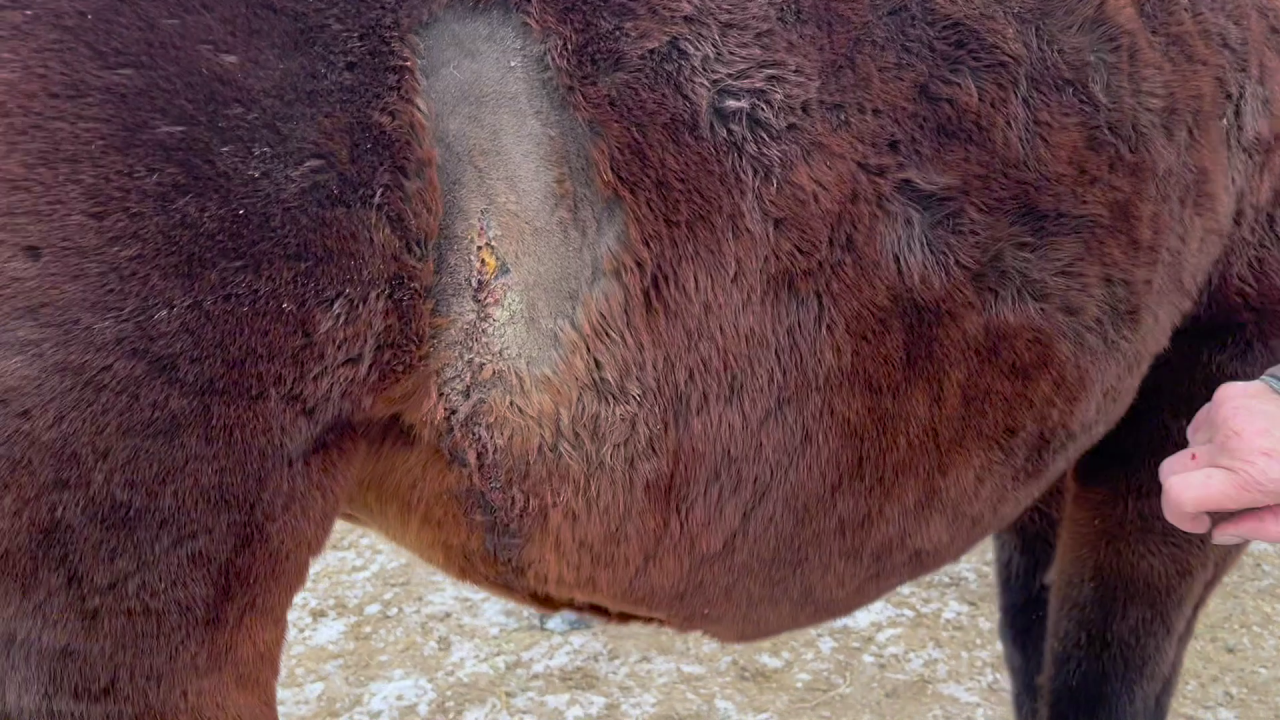A disease outbreak in parts of Montana is worrying some ranchers and veterinarians - "Pigeon Fever."
Jody Jackson of Carter - between Great Falls and Fort Benton - was out to feed her horses noticed something was wrong with one of them.

"It's been a month or six weeks ago, where I had a mare that didn't come up to feed for morning chores, so I investigated why she didn't come up. She had a big, football-sized lump on her chest, and I thought, 'Wow, she'd been kicked.' Then I remember my girlfriend told me the night before about pigeon fever and the abscesses, so I loaded the mare and took her to our vet, and it was certainly pigeon fever."
Pigeon fever is most common in the southwestern United States, such as Texas, New Mexico, and even making its way toward parts of California.
The infection is caused by a bacteria called Corynebacterium pseudotuberculosis, which typically causes large abscesses to form on the chest region of the horse, or under the belly.

The swelling on the horse’s chest resembles a pigeon’s breast, which is how the disease got its name.
Clinical signs include:
- External abscesses – Usually in the chest or abdomen, but may also occur on the mammary gland, groin area, prepuce, triceps, limbs, and head
- Internal abscesses – most commonly seen in the liver, spleen, kidneys, and lungs
- Ulcerative lymphangitis (limb infection along the lymphatic system) – This is usually rare, but is described as a painful infection of the lymphatics, most often involving the hind limbs and causing swelling and oozing sores
Julia Williams is a certified veterinary technician at Associated Vet Services. She said they've seen dozens of cases in the past month.
Williams said, "We've seen at our clinic about 60 cases and diagnosed them as pigeon fever. We've also had multiple people call with signs of it, but we had not seen the horses. We've seen lots of cases, and I'm sure there's more that we haven't seen. We've seen the typical pigeon breast abscesses, we've seen abscesses all over the body, and the two cases that we saw did not make it, so they are pretty severe."

Williams noted the disease is usually transferred. "The bacteria is in the ground and is transferred to horses by flies, so if they have cuts, scrapes, or anything like that, the flies will get into that wound, and that is how it's transferred. It also transferred by pus from the abscesses, so keeping that contained, and fly control, is one of the biggest things to keep aware of."
Williams said, "We have found that antibiotics do not help abscesses, especially when they have not opened. It actually slows the process, so we don't put these horses on antibiotics unless it's an internal case. What Dr. Jack Newman does here is ultrasounds the area, and sees if there's a pocket he can open and drain. Typically, they go home and do fine. We usually keep them controlled and separated from other horses."
Dr. Trace Nydam from Indian Hammer Veterinary Services in Vaughn has experience with pigeon fever in other states, yet this is the first year in Montana he has seen it.
Nydam said, "It is a concern to some degree. You'll have to do some treatments on your horse, but most of the time, it's not life threatening, although it can be. There's some horse-to-horse spreading, but it's mostly caused by insect vectors."

He added, "Most of the abscesses we see are external. Those, they generally recover very quickly. Generally, we do cure it 100 percent. If we get into the internal abscesses, that can be a little more difficult, but antibiotics can take care of the internal cases. The big thing is when we look at an outbreak is to make sure the stalls are clean."
The prognosis for horses with external abscesses is generally good; most recover within a few weeks. With internal infections, however, the prognosis can range from guarded to good, but early recognition and appropriate antibiotic therapy offer the best chance for complete recovery.
Ways to prevent pigeon fever include:
- Fly control, using feed-through products and/or fly repellents, especially on horses with open wounds or draining abscesses. As flies can cause skin inflammation on the chest or in the girth area of some sensitive horses (i.e. midline dermatitis), fly control using fly sheets, spray or ointments is important.
- Regular manure management and sanitation programs should also be established in order to control insect populations.
- Quarantine and observe new horses for signs of infection before they are introduced into the resident population. Isolate known infected horses when possible and practical, wash/sanitize hands after handling infected horses, and use gloves and protective outerwear. Avoid using the same items (buckets, pitchforks, and other materials) for infected horses and the general horse population. Carefully clean and disinfect areas potentially contaminated by pus from draining abscesses. Inspect stalls, paddocks and fields for sharp edges or objects that could cause wounds on your horse’s skin, which might subsequently become infected.
No further precautions are needed once infected horses are recovered and there is no drainage from abscesses.
There is currently no vaccine for pigeon fever. Horses that recover from the disease are often less likely to be affected again in the future.
TRENDING
- Parade Of Lights & Christmas Stroll
- 'Pigeon fever' hits Montana horses
- 2 Butte teens dead after gunshot
- Community Calendar
- MT baker on Food Network show
- Obituary: Eugene "Gene" Carnahan



